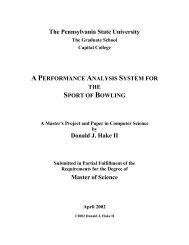k-Nearest Neighbor Classification on Spatial Data Streams Using P ...
k-Nearest Neighbor Classification on Spatial Data Streams Using P ...
k-Nearest Neighbor Classification on Spatial Data Streams Using P ...
You also want an ePaper? Increase the reach of your titles
YUMPU automatically turns print PDFs into web optimized ePapers that Google loves.
n<br />
d q<br />
q X Y ∑ − 1<br />
, ) =<br />
i=<br />
1<br />
i<br />
i<br />
q<br />
i<br />
( w x − y . The Euclidean functi<strong>on</strong> results by setting q to 2 and<br />
each weight, w i , to 1. The Manhattan distance, ∑ − d 1 ( X , Y ) = x i − y i result by setting<br />
i=<br />
1<br />
q to 1. Setting q to ∞, results in the max functi<strong>on</strong> d<br />
∞<br />
n 1<br />
n<br />
= − 1<br />
max<br />
i=<br />
1<br />
( X , Y ) x − y .<br />
In this paper, we introduced a new metric called Higher Order Bit (HOB)<br />
similarity metric and evaluated the effect of all of the above distance metrics in<br />
classificati<strong>on</strong> time and accuracy. HOB distance provides an efficient way of<br />
computing neighborhoods while keeping the classificati<strong>on</strong> accuracy very high.<br />
KNN is a good choice when simplicity and accuracy are the predominant issues.<br />
KNN can be superior when a residual, trained and tested classifiers, such as ID3, has a<br />
short useful lifespan, such as in the case with data streams, where new data arrives<br />
rapidly and the training set is ever changing [1, 2]. For example, in spatial data,<br />
AVHRR images are generated in every <strong>on</strong>e hour and can be viewed as spatial data<br />
streams. The purpose of this paper is to introduce a new KNN-like model, which is<br />
not <strong>on</strong>ly simple and accurate but is also fast – fast enough for use in spatial data<br />
stream classificati<strong>on</strong>.<br />
In this paper we propose a simple and fast KNN-like classificati<strong>on</strong> algorithm for<br />
spatial data using P-trees. P-trees are new, compact, data-mining-ready data<br />
structures, which provide a lossless representati<strong>on</strong> of the original spatial data [6, 9,<br />
10]. In the secti<strong>on</strong> 2, we review the structure of P-trees and various P-tree operati<strong>on</strong>s.<br />
We c<strong>on</strong>sider a space to be represented by a 2-dimensi<strong>on</strong>al array of locati<strong>on</strong>s.<br />
Associated with each locati<strong>on</strong> are various attributes, called bands, such as visible<br />
reflectance intensities (blue, green and red), infrared reflectance intensities (e.g., NIR,<br />
MIR1, MIR2 and TIR) and possibly crop yield quantities, soil attributes and radar<br />
reflectance intensities. We refer to a locati<strong>on</strong> as a pixel in this paper.<br />
<strong>Using</strong> P-trees, we presented two algorithms, <strong>on</strong>e based <strong>on</strong> the max distance metric<br />
and the other based <strong>on</strong> our new HOB distance metric. HOB is the similarity of the<br />
most significant bit positi<strong>on</strong>s in each band. It differs from pure Euclidean similarity<br />
in that it can be an asymmetric functi<strong>on</strong> depending up<strong>on</strong> the bit arrangement of the<br />
values involved. However, it is very fast, very simple and quite accurate. Instead of<br />
using exactly k nearest neighbor (a KNN set), our algorithms build a closed-KNN set<br />
and perform voting <strong>on</strong> this closed-KNN set to find the predicting class. Closed-KNN,<br />
a superset of KNN, is formed by including the pixels, which have the same distance<br />
from the target pixel as some of the pixels in KNN set. Based <strong>on</strong> this similarity<br />
measure, finding nearest neighbors of new samples (pixel to be classified) can be<br />
d<strong>on</strong>e easily and very efficiently using P-trees and we found higher classificati<strong>on</strong><br />
accuracy than traditi<strong>on</strong>al methods <strong>on</strong> c<strong>on</strong>sidered datasets. Detailed definiti<strong>on</strong>s of the<br />
similarity and the algorithms to find nearest neighbors are given in the secti<strong>on</strong> 3. We<br />
provided experimental results and analyses in secti<strong>on</strong> 4. The c<strong>on</strong>clusi<strong>on</strong> is given in<br />
Secti<strong>on</strong> 5.<br />
i<br />
i
















